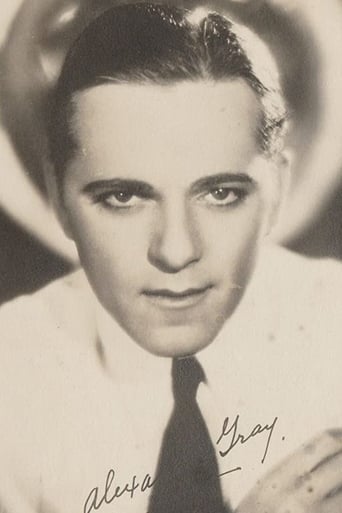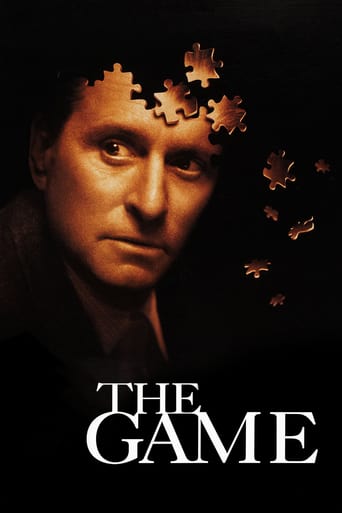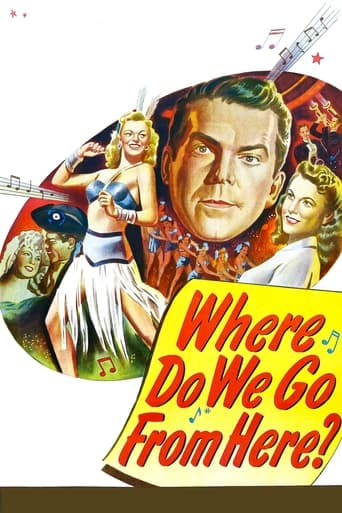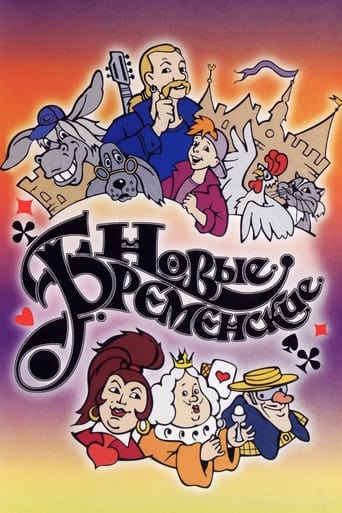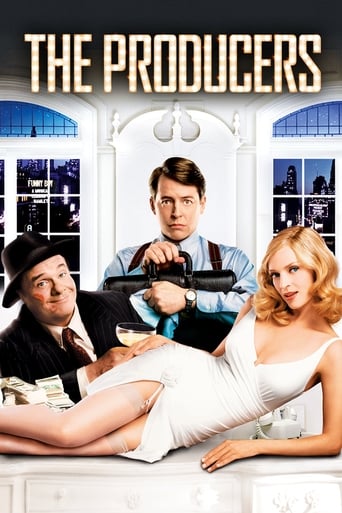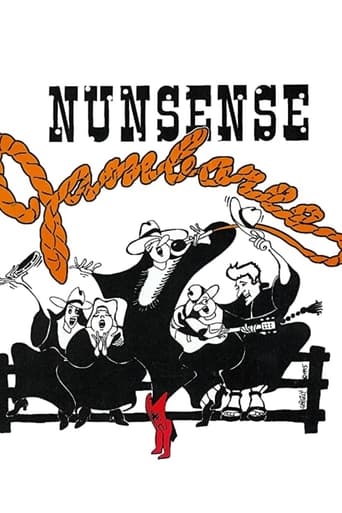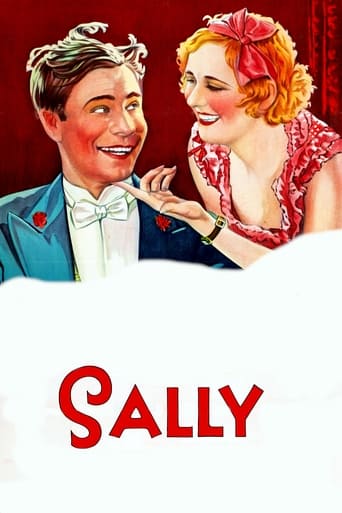

Sally (1930)
Sally is an orphan who was named by the telephone exchange where she was abandoned as a baby. In the orphanage, she discovered the joy of dancing. Working as a waitress, she serves Blair (Alexander Gray), and they both fall for each other, but Blair is engaged to socialite Marcia. Sally is hired to impersonate a famous Russian dancer named Noskerova, but at that engagement, she is found to be a phoney. Undaunted, she proceeds with her life and has a show on Broadway, but she still thinks of Blair.
Watch Trailer
Cast
Similar titles
Reviews
That was an excellent one.
Although I seem to have had higher expectations than I thought, the movie is super entertaining.
A great movie, one of the best of this year. There was a bit of confusion at one point in the plot, but nothing serious.
There are moments in this movie where the great movie it could've been peek out... They're fleeting, here, but they're worth savoring, and they happen often enough to make it worth your while.
SALLY (First National Pictures, 1929), directed by John Francis Dillon, from the Florenz Ziegfeld musical-comedy, introduces stage star Marilyn Miller (1898-1936) to the screen in a role for which she's most principally linked. Although Miller originated "Sally" on Broadway in 1920, it was Colleen Moore who originated the role on screen in the 1925 silent comedy for First National with Leon Errol (who appeared opposite Miller on Broadway) and Lloyd Hughes. For Miller's motion picture debut, her introduction comes with a close up of her feet doing ballet steps before the camera follows them walking over the next table where Sally (in full focus) is seen carrying a tray of food to her next customer. Produced in two-strip Technicolor, with choreography by Larry Ceballos, SALLY is a prestigious start to Miller's short-lived Hollywood career.The story revolves around Sally Green (Marilyn Miller), a young woman raised in an orphanage now earning a living as a waitress at a crowded New York City restaurant, whose one ambition is to become a dancer. After Sally makes an impression on Otis Hooper (T. Roy Barnes), a theatrical agent dining with Rosie (Pert Kelton - almost unrecognizable as a brunette), she loses her chance as well as her job when she accidentally spills a tray of food all over him. Sally acquires another job waiting on tables at the Elm Tree Inn managed by "Pops" Shendoroff (Ford Sterling), with Connie (Joe E. Brown), formerly Constantine, Grand Duke of Checkercovinia, working as a waiter. Sally soon makes the acquaintance of Blair Farell (Alexander Gray), the son of an aristocratic father (E.J. Ratcliffe) who arranged for him to marry socialite Marcia Ten Brook (Nora Lane). Blair, who had earlier noticed Sally through the window of the restaurant, takes an interest in Sally and arranges to have Schendorff dance for the customers, one of them being Otis Hooper. Hooper later encourages Sally to perform at Mrs. Ten Brook's (Maude Turner Gordon) garden party, which she does, under the guise of Madame Noskerova, the famous Russian dancer, at the same time Connie makes his grand entrance as the Grand Duke. When Schendorf gives away their identities, Mrs. Ten Brook orders Sally to leave, which she does after hearing Blair's announced engagement. Although Sally achieves stardom dancing for the Ziegfeld Follies, she finds she's unable to forget about Blair. With music and lyrics by B.G. DeSylva, Al Dubin, Joe Burke, Clifford Grey and Jerome Kern, the musical program is as follows: "Look For the Silver Lining" (sung by Alexander Gray and Marilyn Miller); "Sally" (sung by Alexander Gray); "Look For the Silver Lining" "Sally" and "Look For the Silver Lining" (danced by Miller and Joe E. Brown); "If I'm Dreaming, Don't Wake Me Too Soon" (duet by Miller and Gray); "Walking Off These Balkan Blues" (danced by Joe E. Brown); "All I Want to Do Do Do is Dance" (sung by Miller); "Wild Rose" (sung by Miller and male chorus); "If I'm Dreaming, Don't Wake Me Too Soon" (reprise by Miller and Gray); Russian dance number performed by the Albertina Rasch Ballet; and "Broadway Follies" instrumental ballet/ dance numbers (performed by Miller).With SALLY available in black and white format, only the "Wild Rose" dance sequence survives in its original, yet slightly fuzzy, Technicolor form. The song, "Look for the Silver Lining," most associated with Miller, was used as the title to a Warner Brothers 1949 bio-pic starring June Haver as Marilyn Miller. If the score to "If I'm Dreaming" sounds familiar, it was used for a dance sequence between Douglas Fairbanks Jr. and Glenda Farrell in the gangster classic, LITTLE CAESAR (1930) starring Edward G. Robinson. Alexander Gray, a deep voice baritone, notable for his screen teaming with Bernice Claire in early Warners musicals of 1929-30, is acceptable as the leading man, though wasn't quite the type to survive the movie medium to the next decade. Joe E. Brown, still early in his career before starring in his own comedies, has little opportunity being funny but does provide some highlights, including a comedy dance with Miller, and another as a waiter escorting an old man (Jack Duffy) and his young date (Ethel Stone) up a latter to their table with a view, proving to be troublesome for all. As for Marilyn Miller, she would follow SALLY with more singing, dancing and romancing with SUNNY (1930) and HER MAJESTY, LOVE (1931) before returning to Broadway. Of the three, SALLY is most acceptable mainly for being a recorded document of her stage play, while SUNNY, another screen adaptation, disappoints for anyone who had seen the stage version to find much of the original score missing from the final print. HER MAJESTY, LOVE, intended to be something original, offered nothing new in the genre of sophisticated director, Ernst Lubitsch.With so many 1929-30 musicals currently lost or incomplete, SALLY was fortunate to have survived intact at 100 minutes, even without the color. Unavailable for viewing since its initial theatrical release, SALLY made it to television on Turner Classic Movies in August 1994, where this and other Marilyn Miller musicals enjoyed occasional revivals for the next few years. (***)
This is one early sound film that fortunately is not lost because it gives us the opportunity to see one of the biggest Broadway stars of her era give her breakout performance. Too many people have forgotten Marilyn Miller, she was the Madonna of her day in more ways the one.And in 1919 Sally was the role that made her a Broadway star. It's a Cinderella story, the kind that was popular back in the day. She's a foundling, raised in an orphanage and working as a dishwasher/server at a café where she's discovered. She finds stardom in the Ziegfeld Follies where Marilyn Miller actually did appear and the man of her dreams in Alexander Gray.Of course it's not all smooth sailing and the girl does have to do a stint at a society party masquerading as a fortune hunting dancer from Europe, an idea press agent T. Roy Barnes dreams up when the real dancer who's his client runs out on him. You might remember Barnes best from a small role in It's A Gift where he tries to sell a weary W.C. Fields some insurance. On stage the part was played by Walter Catlett.This was also the film that brought Joe E. Brown a long term contract with Warner Brothers/First National as their leading comic star in the Thirties. Playing a role originated on Broadway by Leon Errol, Brown is the prince of Czechoslovenia who lost the family fortune on fast women and slow horses. He still has the title, but works in the same café as Miller run by an exiled subject Ford Sterling who has some trouble adjusting to the new relationship between prince and former commoner. Miller and Brown have a very good dance number.Speaking of dance that was Miller's real forte. A good singer, she was a terrific dancer as this film shows. In fact because she felt that audiences did not get the full effect of her persona unless they saw the whole act on stage, she refused to make records. Thus her three films with Warner Brothers/First National are the only record we have of her performing. Seeing her dance I understand though don't agree with her point of view.In fact the main problem with Sally is that when Miller did the Broadway show she was a fresh young 21 in 1919. She's now 31 and she partied hardy in the Roaring Twenties. The talent is there, but she looks like a 31 who's seen a bit of the sunny and shady side of life.Of course her signature song, Look For The Silver Lining which Jerome Kern and Buddy DeSylva wrote for her in this show is there. Most of the score is not and two new songs from Joseph Burke and Al Dubin are. One of them, If I'm Dreaming, Don't Wake Me Up Too Soon was revived almost 60 years later and heard as background music during the Oscar ceremony scene in the Bruce Willis-James Garner film Sunset.If people remember Marilyn Miller at all, they remember Judy Garland portraying her in Till The Clouds Roll By and from the biographical film that Warner Brothers did in 1949 with June Haver as Marilyn. Also in MGM's The Great Ziegfeld, the Virginia Bruce character is based on Marilyn Miller. Here's a chance to see the real deal so don't pass it up.
Sally is one of the few films that stars Marilyn Miller, a popular dancer on the Ziegfeld Stage. Her talent as a dancer is utilized here in this breezy film.Sally (Miller) is an orphaned waitress, but all she's ever really wanted to do in life is dance. She meets a wealthy man whose interest in her is strong (Alexander Gray) who helps her to get a job dancing at a nightclub. She is a great success. Also at the club is an ex-Duke (Joe E. Brown) whose hilarious arrogance provides some comedy. He is invited to a high class party where he is to meet a treacherous woman from his past, but since she refuses to show, Sally takes her place. The two pull off a scheme to trick the rest of the guests.The best actor is Brown, a funny character actor whose career spanned for decades. It is no wonder the other leads are practically forgotten today; their acting is quite wooden.The musical numbers can be dull; the singers have operatic voices, not those suited to popular music. However, Miller is able to show how dynamic she is as a dancer. She does a frantic jazz number with awkward steps that were popular in the 20s and she does a graceful ballet number with ease.Also of interest is a color sequence. However, when it begins and ends is very awkward. The film switches to color after a dance number has already started and off again after the number is over and the story has begun again.
Originally filmed in 2-strip Technicolor, this film now survives as a mainly black and white print with some colour footage intact. This rags to riches story (Sally starts from an orphanage and ends up with her own show on Broadway) stars Marilyn Miller - little seen and perhaps only known to film buffs because of Judy Garland's impersonation of her in 'Till The Clouds Roll By'. Miller was a beautiful and talented artist, as 'Sally' proves.Supporting her is a very young Joe E Brown (best known as Captain Andy in the third film version of Show Boat) who is a lot of fun, and Alexander Gray, who like many other leading men of the early talkies is a bit of a stuffed shirt. You'll also spot the Keystone Kops' Ford Sterling as 'Pops'.'Sally' is a hugely enjoyable early talkie. The colour sequence is lovely and bright - it is a pity that we lose the impact from the rest of the film. The songs are good and Miss Miller is a treat to watch. Try to catch this when it next airs on TCM.

